
The UNESCO World Press Freedom Day address
AUT University, 6 May 2014
“No-one died covering celebrity news”
Dr Gavin Ellis
Let me begin by putting New Zealand domestic journalism in context. None of the 16 journalists and nine citizen journalists killed so far this year, according to Reporters Without Borders, died in New Zealand. None of the 169 journalists and 170 Internet citizens languishing in gaol is in a New Zealand prison. The greatest risk a journalist faces in New Zealand is an invasion of her workplace privacy[1] (Andrea Vance) or his reputation being called into question by a state agency[2] (Jon Stephenson). Unless you are a journalist working on Fair Go you are unlikely to be dealt a bloody nose.[3]
So World Press Freedom Day – let’s update that to World Media Freedom Day – exists for me on two planes. One is the opportunity to pay tribute to the courageous men and women who place themselves in danger to report the truth, particularly to those who have paid the ultimate price for their endeavours. It is also to regard with dismay the wholesale denial of the basic human right of free expression. When I wrote the draft of this paper a week ago the statistics I have just read out were different: 11 journalists and 3 citizen journalists killed and 165 journalists and 165 Internet citizens jailed. The change in such a short time is a stark illustration of the rising price journalists pay in the name of free speech.
The other is to reflect on what it means in that domestic context. And with New Zealand once again placed in the top 10 countries on the World Press Freedom Index I might be tempted to say there is not much on which to reflect…beyond our good fortune.
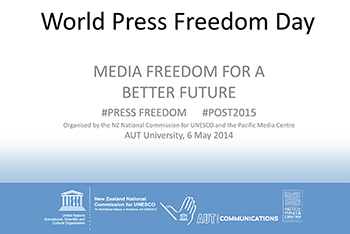 Let’s reflect on that good fortune for a moment. We enjoy freedom of speech, even though the Bill of Rights Act guarantee can be over-ridden. We have a variety of privately owned news media, even though the vast majority are owned by overseas interests. We have state-owned radio and television, even though our major television network was freed of its public service broadcasting obligations in order to pursue commercial goals. We have high quality tertiary institutions to train our future journalists, even though the ranks of our newsrooms have been systematically depleted. We have sophisticated telecommunications services, even though only 1 per cent of us have optical broadband. The qualifications will not be lost on you. In other words, when I reflect on our good fortune I see that it is tempered by shortcomings, actual and potential. In this address I will argue that the shortcomings are increasing and, if unchecked, ultimately threaten the way we function as a society.
Let’s reflect on that good fortune for a moment. We enjoy freedom of speech, even though the Bill of Rights Act guarantee can be over-ridden. We have a variety of privately owned news media, even though the vast majority are owned by overseas interests. We have state-owned radio and television, even though our major television network was freed of its public service broadcasting obligations in order to pursue commercial goals. We have high quality tertiary institutions to train our future journalists, even though the ranks of our newsrooms have been systematically depleted. We have sophisticated telecommunications services, even though only 1 per cent of us have optical broadband. The qualifications will not be lost on you. In other words, when I reflect on our good fortune I see that it is tempered by shortcomings, actual and potential. In this address I will argue that the shortcomings are increasing and, if unchecked, ultimately threaten the way we function as a society.
There is a fundamental danger in taking freedom for granted, in believing that as a developed country, we have already secured the freedoms for which others continue to strive. Development, in this sense, is seen as a linear process that begins at ‘undeveloped’, progresses through ‘under-developed’ and ‘developing’ to ‘developed’. It has a start point and a finish point. A ‘developed’ state remains ‘developed’ in the same way that we see ‘progress’ as positively irreversible.
However, when we consider the political economy of communication in New Zealand I believe we have, in fact, embarked on a return path. We have reverted from ‘developed’ to ‘developing’. Let me qualify that a little. The basic freedoms remain in place. We do have freedom of expression (tempered by concomitant responsibilities) and our media is unconstrained in the usual contexts of press freedom. Our media is not licensed by the state and our journalists are not subject to coercion or repression. What has placed us on that regressive path is a growing inability by our mainstream news media to discharge the societal obligations that these freedoms place on them.
When news media were granted -- or took to themselves -- the rights that exist under these freedoms, they assumed a mantle that otherwise would be placed on the shoulders of individuals. Media were able to don that mantle because they had the ability to exercise those freedoms on behalf of a great number of people. A mass media organisation was able, on the one hand, to disseminate the same message to many people and, on the other hand, to hold the powerful to account by virtue of that broad reach.
Michael Gurevitch and Jay Blumler, in an essay on political communication systems and democratic values, said: “Democracy is a highly exacting creed in its expectations of the mass media”. They went on to list eight principal functions that included surveillance of the socio-political – note: not simply the political but the socio-political – system, meaningful agenda setting, platforms for advocacy and debate, and holding officials to account for how they exercise power. Gurevitch & Blumler went on to describe four kinds of obstacle that stood in the way of meeting those expectations, the final barrier being the fact that “the media can pursue democratic values only in ways that are compatible with the socio-political and economic environment in which they operate.[4] Political communication arrangements follow the contours of and derive their resources from the society of which they are a part.” They took a pragmatic view: Media organisations’ pursuit of their democratic role was “inexorably shaped” by their over-riding economic goal of survival (and, if possible, prosperity) in a competitive marketplace.
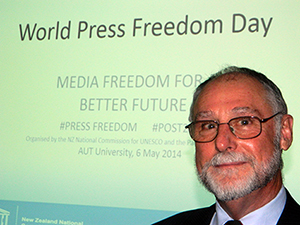 It is this that has pushed us back from ‘developed’ to ‘developing’ in the political economy of communication. It is an over-riding economic goal – and not the repressive actions of power-craving politicians – that threatens the substance of our journalism. That economic goal is not the sustenance of our journalism but the satisfying of investors. There was once a notion that ‘the news business’ was set apart from commerce and given a higher calling – the ‘church’ that sits, like the Vatican City, inside the commercial ‘state’ of a media organisation. That notion may continue to exist in terms of editors invoking it to limit (but no longer eliminate) commercial influences, but the idea that the news should be placed on a pedestal died when accountants began to rule the newsroom and chief executives began to have sleepless nights over how to keep shareholders satisfied.
It is this that has pushed us back from ‘developed’ to ‘developing’ in the political economy of communication. It is an over-riding economic goal – and not the repressive actions of power-craving politicians – that threatens the substance of our journalism. That economic goal is not the sustenance of our journalism but the satisfying of investors. There was once a notion that ‘the news business’ was set apart from commerce and given a higher calling – the ‘church’ that sits, like the Vatican City, inside the commercial ‘state’ of a media organisation. That notion may continue to exist in terms of editors invoking it to limit (but no longer eliminate) commercial influences, but the idea that the news should be placed on a pedestal died when accountants began to rule the newsroom and chief executives began to have sleepless nights over how to keep shareholders satisfied.
In order to understand how this situation came about we need to look back over time. There is a remarkably similar pattern in the news organisations of the English-speaking world so I will use American examples to show you what happened. I can assure you that similar patterns were followed here and in Australia. News media organisations went through four phases:
· Growth: the decades following WW2 when both newspaper readership and broadcasting audiences grew exponentially.
· Concentration: The period when owners either sought to expand by buying other media companies or realised the wealth that had accumulated in their businesses by selling out.
· Destabilisation: When the cost of acquisition increased considerably and media groups (as they had now become) had to borrow heavily to increase the size of their balance sheets at a time that revenue was starting to fall.
· Danger: The present situation where the need to service high debt, the effects of the Internet on both audience and advertising revenue, and the Global Financial Crisis dramatically affected financial performance.
The charts in Figure 1 show a rapid fall-off of newspaper revenue and, while the timeframe is a little different, broadcasters have felt similar effects on their revenue. However, the effect on newspaper companies has been little short of disastrous. There have been massive write-downs in the value of Australasian media companies. In 2012 $A4.2 billion was taken off the balance sheets:
• Fairfax $A 2.8 billion
• APN $A 485 million (NZ titles)
• News Corp $A 731 million
• MediaWorks $NZ242 million (SA193 million)

Media companies have been under considerable pressure from investors to improve their fortunes. I have found a common bottom line approach among media companies that is best illustrated by the historical example of the Gannett Company under Al Neuharth and his predecessor Paul Miller. The American group reported 80 uninterrupted quarters of earnings gains but that was not the result of ever-increasing revenue. In the bad years Gannett simply cut its budgets and editorial budgets were prime targets. Neuharth summarised his business philosophy in his autobiography Confessions of an S.O.B.: Analysts didn’t want to know how many journalism prizes had been won or the quality of editors and journalists. The bottom line was paramount – “Gannett was a dependable profit machine in good times and bad”.
For the past seven years, the times have been bad but newspaper companies, in particular, had already weakened their editorial resources as their fortunes fluctuated in the 1990s and the beginning of the 21st century. My own experience over that period was of attrition, with newsroom numbers systematically reduced. The result was that they entered the Global Finance Crisis ill-prepared to withstand its effects. Let me again use an American example (Figure 2 which shows a dramatic decline total employment in the newspaper industry – as measured by the UD Bureau of Labor Statistics – to levels below those in 1947) to demonstrate the effect that this perfect storm has had on resources.
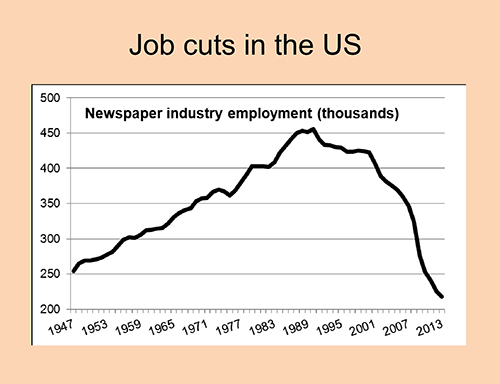
In New Zealand, APN has systematically reduced its workforce. In 2007 its New Zealand media operations – the most significant of which is the New Zealand Herald – employed 2068 people. By 2013 this number had been cut in half – to 1037.[5] Fairfax NZ cut 150 jobs in 2012, 36 of them journalist positions. TVNZ lost 90 jobs in 2009 and a further 75 in 2012. Added to the newspaper newsroom losses was the closure of the New Zealand Press Association in 2011. It was replaced by in-house services established by Fairfax and APN but the result has been a reduction in the overall geographic coverage of news.
The sum effect of this erosion of resources and the commercial fortunes of news media companies has two-fold. Newsrooms have been forced to reduce both the range and duration of coverage, and to succumb to commercial pressure to produce both ‘infotainment’ and front pages that appeal to prurient impulse buyers.
It is not a zero-sum game. Within the pages of our newspapers, online, and in news and current affairs programmes we continue to find examples of good journalism. However, both the gaps and the over-riding emphasis in news media point to what I describe as a democratic deficit.
I undertook a survey earlier this year in which I examined the front page lead stories in five New Zealand daily newspapers during the month of January.[6] The survey was limited to weekdays as weekend editions were not uniform across all titles. The results (Figure 3) showed a marked leaning toward the newspaper adage: “if it bleeds, it leads”.
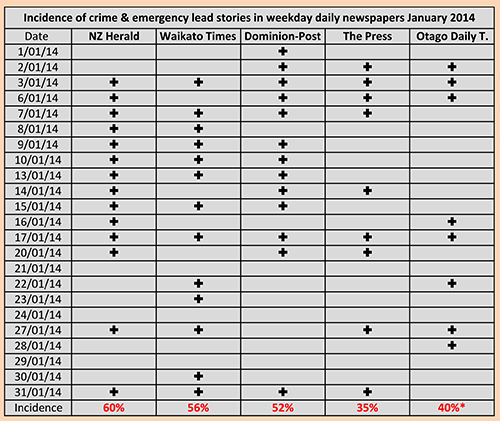
While the overall incidence of crime and emergency lead stories diminished from north to south, the percentage of such stories in the New Zealand Herald, Waikato Times and Dominion-Post were uniformly high. Equally disturbing was the ‘clustering’ that saw such stories leading newspapers for days – sometimes weeks – on end. These were not the result of a single incident that continued to dominate the news columns. In the majority of cases the topic changed from day to day. Also noteworthy was the elevation to the front page of traffic accidents which, tragic though they may be, in previous times appeared in the briefs column on page 3. The survey gave rise to a question: Were these the most important newsworthy issues in New Zealand at the time the respective newspapers went to press?
The answer, of course, must be ‘no’. However, such news judgment is indicative of a shift away from providing information that people need to know, toward a marketer’s perception of information that people want to know. The Reithian concept of fostering a reasoning citizenry has become a presumptuous imposition, to be displaced by the commercialized view that news media are there to give customers what they desire. If they desire celebrity news, they shall have celebrity news. There is an added bonus: breathless prose on Gwyneth Paltrow’s marital status or Miley Cyrus’ bizarre interpretation of womanhood is easier and cheaper to publish than well-researched accessible articles on complex subjects or contextualized accounts from the world’s strategic danger zones. And, as the title of this lecture states, no-one died covering celebrity news.
However, something has been gouged out in order to meet customers’ desire and shareholders’ demands. Today we may have multitudinous threads of information but what had been taken from us is the warp and weft that weaves a fabric of social understanding. By that I mean the thoughts, actions and outcomes that contribute to the way a society works. As a mass we are no longer told of the normal functionings of the institutions that collectively hold our community together. We are told when an institution is beset by claims of corruption or wholesale malfunction but we are not told of the decisions made on our behalf that contribute to its proper functioning – day-to-day news.
John Zaller tells us this “full news” standard (he gives the New York Times as an example) is not necessary for the average citizen, who needs only what he calls “burglar alarm news”. “The key idea,” he says, “ is that news should provide information in the manner of attention-catching “burglar alarms” about acute problems, rather than ‘police patrols’ over vast areas that pose no immediate problems.” [7]
This suggests the only role for modern news media is to tell us when things are wrong or where there are problems. If so, it is a sad turn of events. In 1947, the Hutchins Commission on Freedom of the Press in the United States gave us a definition of the role of the press or, more accurately, a prescription for the responsibilities it needed to discharge in return for the special privilege it enjoyed under the First Amendment. I see no reason why those responsibilities should be either diminished or abrogated. This is what the commission said:
Today our society needs, first, a truthful, comprehensive, and intelligent account of the days events in a context which gives them meaning; second, a forum for the exchange of comment and criticism; third, a means of projecting the opinions and attitudes of the groups in society to one another; fourth, a method of presenting and clarifying the goals and values of the society; and, fifth, a way of reaching every member of the society by the currents of information, thought, and feeling which the press supplies.
The Internet, if seen in a perfect state, could discharge the first four responsibilities. In its actual imperfect state it meets the second criteria and is, at best, a haphazard carrier of the first and third. However, it invariably fails to meet the last criteria. Mass media has had the ability to convey the same piece of information to very large numbers of people. The highly fragmented and, at times, anarchic nature of the Internet prevents it from carrying this consistent thread to most citizens and, thereby, allowing them to form opinions based on the same information.
However, the first responsibility is increasingly difficult for the news media to discharge and, in particular, the provision of comprehensive coverage. Approached simply, we might see three contributing causes:
· Resources
· Space or airtime
· Commitment
However, the news business is a complex one in which numerous factors interact. I have attempted, in my forthcoming book Trust Ownership and the Future of News: Media moguls and white knights, to provide a model of this complex interaction. I have called it a model of news media organisation dynamics (Figure 4). I owe the basic concept – 3-D chess – to a short story by Isaac Asimov but must take personal responsibility for the complexities I have added. Unlike conventional chess, it plays in three dimensions and, in our case, the aim is not to capture the king but to occupy particular territory. Each board in the stack represent a particular form of influence on the news game – Financials, Market, Technology, Regulation, Governance, Leadership, Culture, and Engagement – and each space has a value. An organisation’s place on a particular board will be determined by its performance on scales along each horizontal axis, acknowledging that some measurements will be inherently subjective. Each board interacts with those above or below it, either influencing or being influenced by them. For example, a high level of civic engagement serving a diverse range of communities is likely to have a strong culture based on social benefits. Conversely, a weak internal culture that places little store by social benefits will betray both ineffective leadership and poor civic engagement.
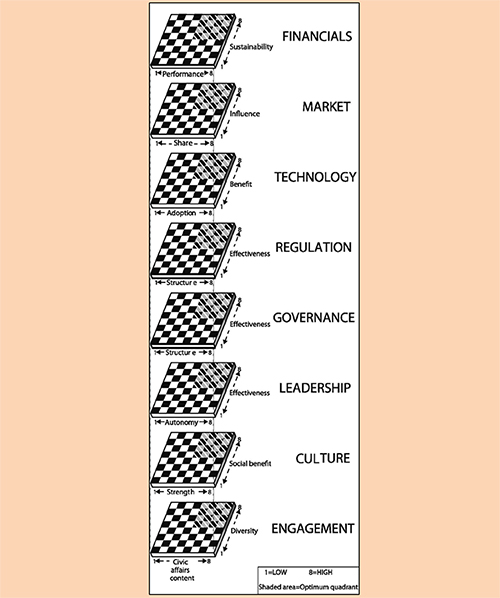
A media outlet is most likely to produce the sort of journalism that the Hutchins Commission had in mind if its custodians aim to occupy particular optimum quadrants that contribute to such an outcome. News media with different aspirations – entertainment-driven tabloids, for example – would say that some of their optimum quadrants lay elsewhere on the boards. Just as the market orientation of a publication can affect its performance within the matrix so, too, can the preferred strategies employed by the organisation. Hence, a publication’s position will be influenced by the over-arching decisions made by its chessmaster.
Further factors complicate the picture: the interactive influences symbolised by each board are neither equal nor uniform. The effect of financial performance permeates through other layers of the matrix in ways that factors such as regulation and engagement do not. The market is more of an influence in a field of several media players than in a monopoly. Technology uptake must be seen in light of the technological environment within which the news organisation is situated. Regulation may exert a stronger influence in times of political stress – war or terrorism, for example – than in periods of peace and prosperity. And so on. The interactions are, indeed, complex but it is the organisational and institutional structure of the organisation that has the most profound effect.
The central thesis of my book is that, if we are to sustain a news media environment that has democratically significant journalism – essentially the tenets described by the Hutchins Commission – we need to reconstruct part of that environment. The reconstruction must produce a more diverse range of entities. I am ever mindful of the democratic challenge posed by the late C. Edwin Baker: “A country is democratic only to the extent that its media, as well as elections, are structurally egalitarian and politically salient”.
Our regression from a developed state cannot be overcome simply by restoring old structures. The business model that produced the ‘rivers of gold’ in advertising revenue has been shaken to its core and the attraction that news media once represented to the sharemarket has dimmed to the point where shares worth, say, $5 a decade ago now trade for 50 cents. We need new structures whose purpose is the sustaining of journalism that serves, first and foremost, a social purpose. They should be self-sustaining private sector endeavours. Our state-sector public service broadcasting serves a vital purpose but there are dangers in placing too heavy a reliance on state-funded entities when the watched hold the watcher’s purse strings. Self-sustaining private sector endeavours would seek revenue to cover the costs of their journalism, not to enlarge dividend accounts.
It is essential that they be governed by a form of trusteeship – an over-riding commitment to socially responsible journalism – but their legal structure can assume a number of forms. I will not discuss those forms here, although you can imagine my support for trusts and companies that act like trusts. Given the economics of the news industry, it is likely that the majority of structures committed to “full news” will need assistance simply to become self-sustaining. If they are committed to the retention of all ‘profits’ for the purposes of supporting and extending social purpose journalism, they should be entitled to tax dispensations plus incentives for donors willing to financially support them. This will require official recognition of certain types of journalism as a social purpose that can attract a newly created charitable status. Journalism currently does not constitute a charitable purpose and attempts to change its status have fallen on deaf ears. Journalism per se is unlikely to attract such recognition – financial journalism and entertainment news would struggle to pass the grade – and attempts to differentiate between certain types of journalism are fraught with problems. However, organisations established or committed predominantly to the provision of certain types of journalism could demonstrate a social purpose that entitled them to tax concessions that would contribute toward their sustainability.
That, however, is not a pre-requisite. There are, in other parts of the world, organisations that have taken up the challenge of this social purpose while operating in a normal commercial environment. The Guardian, Irish Times and Tampa Bay Times in Florida are newspapers renowned for their commitment. It is no accident, however, that each is owed by a trust-like entity. And we are seeing some of the holes in the fabric being repaired by non-profit start-ups like ProPublica, the Centre for Investigative Reporting and the Center for Public Integrity in the United States, the Bureau of Investigative Journalism in London and the Australian Centre for Independent Journalism in Sydney. Efforts to establish stand-alone investigative units are underway in this country, beginning with the New Zealand Centre for Investigative Journalism started by James Hollings, Keith Ng and Nicky Hager. In Auckland we have Kane Glass’ efforts to cover local government on his AllAboutAuckland website.
The challenge will be to establish an entity, or entities, that have the ability to reach a mass audience. And here I am reminded of the Hutchins Commission’s fifth requirement of a socially responsible press: “[providing] a way of reaching every member of the society by the currents of information, thought, and feeling”. That will mean either by entering the realm of traditional mainstream media or harnessing the digital environment. In the latter case, the second challenge – the first will be survival and sustainability – will be to find a formula that gives the digital medium a comparable power and reach to that of traditional mainstream publications.
Of course, an alternative would be for existing traditional mainstream media to undergo a sea change. A more fitting analogy may be a conversion on the road to Damascus because, I fear, it may take a something approaching divine intervention before private sector media companies revert to a ‘full news’ model – with all of the implications for resourcing and market reorientation. By definition, investor-owned companies owe their legal duty to those investors and not to an altruistic ideal.
There is an inference here that those investors’ interests are best served by giving the market what it wants rather than what it needs. The front page dripping blood is the newspaper equivalent of a breakfast cereal containing five spoonsful of sugar per serving. It is a sad fact that many in the potential news audience have as much interest in seeing themselves as engaged citizens as they do in a sugar-free diet.
This, however, gives rise to several points. First, the slavish attention to the non-engaged segment of society denies the engaged the information they can rightly expect from their news media. Secondly, non-engagement is a trait that a socially responsible media would wish to see diminished. Thirdly, society itself should be concerned at the levels of non-engagement and require of its government policies to foster greater participation. A starting point to the long process of changing social attitudes would be an emphasis on civics in the core curricula of primary and secondary schools. One of the subjects could be the role of socially responsible media in a democracy – emphasising the positives rather than painting the news media as villain.
It may take a cathartic moment to bring about changed attitudes in both the audience and the news media. That is not impossible as the Christchurch earthquake demonstrates. The front page of The Press is less likely to feature attention-getting crime and emergencies than its metropolitan compatriots. That is because the citizens of Christchurch need to know about the reconstruction of their community. And its recorded crime rate in 2013 was higher than Wellington. No-one would wish such a seismic catalyst on anyone but our communities need to be jolted out of complacency and begin to demand a prioritising of socially responsible journalism over True Crime.
David Robie, at the launch of his new book Don’t Spoil My Beautiful Face here at AUT a fortnight ago, spoke of the need for critical development journalism in the Pacific. It has parallels with investigative journalism but focuses on the conditions in developing nations and ways of improving them. In New Zealand we need a variant that might be called critical post-development journalism: it focuses on the conditions in a developed nation and how to sustain them.
It will still hold the powerful to account, still inform us of the tragedies that befall us and others, still entertain us, still titillate us with celebrity tales (so long as no-one dies covering it) but first and foremost it will see its role in the context that the playwright Arthur Millar characterised a good newspaper: “a nation talking to itself”. Only then can the news media fully discharge the social responsibilities that flow from the freedoms we are here today to recognise.
References:
Baker, C. E. (2007). Media Concentration and Democracy: Why ownership matters. New York, Cambridge University Press.
Ellis, G. (2014 ). Trust Ownership and the Future of News: Media moguls and white knights. London, Palgrave (forthcoming June 2014).
Gurevitch, M. & J. Blumler. (1990). Political Communication Systems and Democratic Values. Democracy and the Mass Media. J. Lichtenberg. Cambridge, Cambridge University Press: 269-287.
Hutchins, R. [chairman]. (1947). A free and responsible press. A general report on mass communication: Newspapers, radio, motion pictures, magazines and books. Chicago, University of Chicago Press.
Neuharth, A. (1989). Confessions of an S.O.B. New York, Doubleday.
Robie, D. (2014). Don't Spoil My Beautiful Face. Auckland, Little Island Press & Pacific Media Centre.
Schudson, M. (1998). The Good Citizen. New York, Free Press.
Zaller, J. (2003). "A New Standard of News Quality: Burglar Alarms for the Monitorial Citizen." Political Communication 20(2): 109-130.
[1]Dominion-Post journalist Andrea Vance had her parliamentary telephone and building access records accessed during an investigation into the leaking of a report into the Government Communications Security Bureau in 2013.
[2]Investigative journalist Jon Stephenson took defamation proceedings against the New Zealand Defence Force in 2013 after claims that he had fabricated a story while covering events in Afghanistan.
[3]A reporter for the Fair Go consumer affairs television programme received a black eye, bleeding nose and suspected concussion after being assaulted in July 2011 while filming a segment outside a car dealership. The assailant was convicted and fined.
[4]The other barriers were i. conflicts over the interpretation and application of democratic values, ii. the distance between authoritative political communicators and ordinary people and, iii. a limited politically-engaged audience.
[5]Presentation by NZ Media chief executive Martin Simons to APN New & Media AGM 2 May 2013.
[6]January is traditionally known as the “silly season” as organisations close for the Christmas-New Year break. The lower percentage of crime and emergency lead stories in South Island newspapers suggests that such leads were not a result of no other news being available.
[7]Zaller draws on Michael Schudson’s concept of the “monitorial citizen” who is watchful, while doing something else, but who does not have the time or inclination to follow the particulars of public affairs.
Ellis, Gavin (2014). 'No-one died covering celebrity news' [UNESCO NZ World Press Freedom Day Lecture 2014]. Presented at Auckland University of Technology, 6 May 2014. Weblink: http://tinyurl.com/q5qbzrh
NZ media 'incapable of serving society', says author
Academic calls for trusts to run non-profit media outlets


